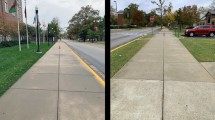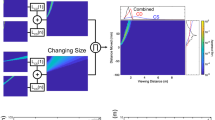Abstract
By itself, the absolute distance of an object cannot be accurately judged beyond 2–3 m (refs 1–3). Yet, when it is viewed with reference to a flat terrain, humans accurately judge the absolute distance of the object up to 20 m, an ability that is important for various actions4,5,6,7,8. Here we provide evidence that this is accomplished by integrating local patches of ground information into a global surface reference frame. We first show that restricting an observer's visual field of view to the local ground area around the target leads to distance underestimation, indicating that a relatively wide expanse of the ground surface is required for accurate distance judgement. Second, as proof of surface integration, we show that even with the restricted view, the observer can accurately judge absolute distance by scanning local patches of the ground surface, bit by bit, from near to far, but not in the reverse direction. This finding also reveals that the surface integration process uses the near-ground-surface information as a foundation for surface representation, and extrapolation to the far ground surface around the target for accurate absolute distance computation.
This is a preview of subscription content, access via your institution
Access options
Subscribe to this journal
Receive 51 print issues and online access
$199.00 per year
only $3.90 per issue
Buy this article
- Purchase on Springer Link
- Instant access to full article PDF
Prices may be subject to local taxes which are calculated during checkout




Similar content being viewed by others
References
Gogel, W. C. & Tietz, J. D. A comparison of oculomotor and motion parallax cues of egocentric distance. Vision Res. 19, 1161–1170 (1979)
Philbeck, J. W. & Loomis, J. M. Comparison of two indicators of perceived egocentric distance under full-cue and reduced-cue conditions. J. Exp. Psychol. Hum. Percept. Perform. 23, 72–85 (1997)
Ooi, T. L., Wu, B. & He, Z. J. Distance determined by the angular declination below the horizon. Nature 414, 197–200 (2001)
Thomson, J. A. Is continuous visual monitoring necessary in visually guided locomotion? J. Exp. Psychol. Hum. Percept. Perform. 9, 427–443 (1983)
Rieser, J. J., Ashmead, D., Talor, C. & Youngquist, G. Visual perception and the guidance of locomotion without vision to previously seen targets. Perception 19, 675–689 (1990)
Loomis, J., DaSilva, J., Fujita, N. & Fukusima, S. Visual space perception and visually directed action. J. Exp. Psychol. 18, 906–921 (1992)
Loomis, J., DaSilva, J., Philbeck, J. W. & Fukusima, S. Visual perception of location and distance. Curr. Dir. Psychol. Sci. 5, 72–77 (1996)
Sinai, M. J., Ooi, T. L. & He, Z. J. Terrain influences the accurate judgement of distance. Nature 395, 497–500 (1998)
Loomis, J. M. & Knapp, J. M. in Virtual and Adaptive Environments (eds Hettinger, L. J. & Hass, M. W.) 21–46 (Erlbaum, Hillsdale, New Jersey, 2003)
Hagen, M. A., Jones, R. K. & Reed, E. S. On a neglected variable in theories of pictorial perception: Truncation of the visual field. Percept. Psychophys. 23, 326–330 (1978)
Dolezal, H. Living in a World Transformed: Perceptual and Performatory Adaptation to Visual Distortion (Academic, New York, 1982)
Loomis, J. M. & Philbeck, J. W. Is the anisotropy of perceived 3-D shape invariant across scale? Percept. Psychophys. 61, 397–402 (1999)
Loomis, J. M., Philbeck, J. W. & Zahorik, P. Dissociation of location and shape in visual space. J. Exp. Psychol. Hum. Percept. Perform. 28, 1202–1212 (2002)
Gibson, J. J. The Perception of the Visual World (Houghton, Mifflin, Boston, Massachusetts, 1950)
Gibson, J. J. The perception of visual surfaces. Am. J. Psychol. 63, 367–384 (1950)
Freeman, R. B. Jr Effect of size on visual slant. Psychol. Rev. 72, 501–504 (1956)
Braunstein, M. L. Motion and texture as sources of slant information. J. Exp. Psychol. 78, 247–253 (1968)
Gibson, J. J. & Cornsweet, J. The perceived slant of visual surfaces—optical and geographical. J. Exp. Psychol. 44, 11–15 (1952)
Sedgwick, H. A. in Handbook of Perception and Human Performance (eds Boff, K. R., Kaufman, L. & Thomas, J. P.) 21.1–21.57 (Willey, New York, 1986)
Meng, J. C. & Sedgwick, H. A. Distance perception mediated through nested contact relations among surface. Percept. Psychophys. 63, 1–15 (2001)
Land, M. F. Scanning eye movements in a heteropod mollusc. J. Exp. Biol. 96, 427–430 (1982)
Land, M. F. Motion and vision: why animals move their eyes. J. Comp. Physiol. A 185, 341–352 (1999)
Acknowledgements
This research was supported in part by a grant from NIH to Z.J.H. and T.L.O. and by a RIG grant from the University of Louisville to Z.J.H.
Author information
Authors and Affiliations
Corresponding authors
Ethics declarations
Competing interests
The authors declare that they have no competing financial interests.
Rights and permissions
About this article
Cite this article
Wu, B., Ooi, T. & He, Z. Perceiving distance accurately by a directional process of integrating ground information. Nature 428, 73–77 (2004). https://doi.org/10.1038/nature02350
Received:
Accepted:
Issue Date:
DOI: https://doi.org/10.1038/nature02350
This article is cited by
-
Measuring up the World in Size and Distance Perception
Erkenntnis (2024)
-
Investigating the influence of visuospatial stimuli on driver’s speed perception: a laboratory study
Cognitive Research: Principles and Implications (2023)
-
Contributions of pictorial and binocular cues to the perception of distance in virtual reality
Virtual Reality (2021)
-
Navigating with peripheral field loss in a museum: learning impairments due to environmental complexity
Cognitive Research: Principles and Implications (2019)
-
Auditory environmental context affects visual distance perception
Scientific Reports (2017)
Comments
By submitting a comment you agree to abide by our Terms and Community Guidelines. If you find something abusive or that does not comply with our terms or guidelines please flag it as inappropriate.



